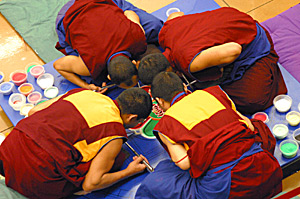 |
|
RANDY METCALF/Arizona Daily Wildcat
|
Four Tibetan monks lean over a Mandala, an ancient form of sand art that symbolizes peace and healing, in the UofA BookStore Tuesday. The monks will be on campus through Sunday demonstrating ceremonies and rituals as part of a tour across the United States to share Tibetan culture.
|
|
|
By Walter E. Staton
Arizona Daily Wildcat
Thursday, February 12, 2004
Print this
Sitting on blue and teal pillows, a Tibetan monk draped in a maroon robe leaned close to the ground to touch up a yin and yang symbol the size of a thumbnail.
The symbol is a tiny detail in a colorfully intricate sand art piece called a "mandala" that 11 monks are creating in the UofA Bookstore.
Tsewang Dorje took a break from working on the mandala and sat behind the information table, dispensing literature to curious onlookers.
The group has been traveling in the United States for six months. It has visited universities and high schools in 18 states so far, sharing its culture and traditions with people across the country.
The monks take turns working on the sand mandala so they can rest, eat and staff their information and gift tables.
"Your back gets very sore from leaning over," Dorje said, as he rubbed his lower back. "We must also breath slowly and be careful not to sneeze."
It will take the monks five days to finish the dinner table-sized art. Then they will destroy it.
Creating the mandala requires patience, Dorje said. Up to four monks work on it at a time, bent over to meticulously place brightly colored sand on a blue platform. The design was sketched onto the platform when the monks began their work Tuesday.
The sand is poured through long, narrow funnels called "chakpurs." The monks each use two ridged chakpurs to pour the sand into place. They fill one chakpur with sand and rub it with the other, causing a small amount of sand to trickle out.
Dorje explained the mandala is created for the Buddha and for healing.
"Everybody needs peace and love," Dorje said.
The monks meditate while they work, reciting prayers and scripture. Dorje described the mandala as a palace for meditation.
Sometimes they briefly chat with each other in Tibetan while they refill or change sand colors. Otherwise, the only sound coming from the mandala is the rattlesnake-like noise of the chakpurs rubbing together.
Dorje, along with the other monks, studies at the Drepung Gomang Monastery in Southeast India. They spent the past year learning how to make sand mandalas for their trip to America, Dorje said.
Drepung Gomang was the largest monastery in Tibet before the Chinese occupied Tibet in 1959 and destroyed the monastery, Dorje said. Many monks were exiled to India, where they have rebuilt the monastary.
Dorje, now 28, joined the monastery when he was 9 years old. He had never traveled to America but is enjoying his experience here.
"It's amazing. You have great roads and continuous electricity. It's very nice," Dorje said.
He also said he likes eating at McDonald's and Burger King. "We always look for the big yellow M," he said.
Behind the monks and Mandala is the technology store in the bookstore.
"We are doing ancient technology next to modern technology," Dorje said, looking at the monks and then pointing to the computers.
Chairs have been set up around the mandala for people to sit and watch the monks work. Since they began Tuesday, Dorje said there has been a steady stream of people coming to observe. He is pleased to see so many people showing an interest in Tibetan culture.
"I've been interested in Buddhism for a while," said Timothy Arbon, a studio art junior. Arbon said he was surprised to see the monks on campus. He spent about an hour yesterday watching them work, and plans to keep checking in each day until they are done.
Arbon also attended the monks' Tuesday night performance, which included dancing and chanting.
"It's very peaceful watching them work," said Erik Zimmerman, an international
studies sophomore. Zimmerman watched the monks from the landing on the bookstore's staircase. He said he was impressed with how incredibly precise and intricate the monks' work is.
The mandala also represents impermanence, a key theme of Buddhism. Sunday, after the mandala is complete, the monks will sweep the sand away.
Dorje said people become upset when the mandala is destroyed. But that is part of its symbolism.
"It's just sand," Dorje said. "We bring the sand together to create something beautiful."
In addition to creating the mandala, the monks will perform ceremonies and rituals on campus through Sunday.
For more information, visit the monks in the UofA Bookstore or go to clubs.arizona.edu/~azsfft.
